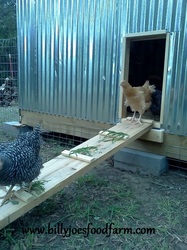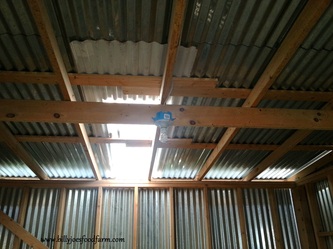We moved to this property in November of 2010, and it had never been used as a farm with animals. The back land had been farmed for hay, and twenty five years ago (before the house was built), there were horses kept on the property, but when we bought the place it was not set up for homesteaders.
Our new place does have a barn that had been used in the past for the horses, but it was wide open on the inside, with no stalls or gates. The people we bought the place from had used the barn for storage, and had stripped it bare of any livestock keeping capabilites. We had our work cut out for us to try and build, bit by bit, into self sufficiency. I figure that might take the rest of our lives.
The first animals I purchased were day old chicks; 14 Buff Orpingtons and 13 Barred Plymouth Rocks. When they arrived of course I had no coop, and it was freezing outside anyway. We set up an area in
the basement with a heat lamp, some wood chips, and some hastily screwed together pieces of wood to make a rectangle shaped enclosure. We then got to work figuring out what we wanted for the coop. I still to this day have a terrible habit of buying the animals that are part of my plan BEFORE I have their enlcosure or fencing done, but I suppose that is another post for another day.
While we were trying to get the coop finished, the birds grew to the point that we could no longer keep them in the house. We moved them out to the shop, into a big round bale holder that was out in one of the pastures that was here when moved in. It worked well for the teenaged birds through January and February, and we kept a couple of heat lamps there for them to keep them warm as they finished feathering out. Toward the end of their stay in the shop, the birds had all their feathers and could fly out of the trough. As a result, the shop was COVERED in poo; we couldn't get the coop done fast enough.
We built our chicken coop off of the ground so digging predators couldn't tunnel into the building, and the walls are metal so snakes can't slither up into it. The hatch has a lock on the inside, so the raccoons and possums can't raid the joint at night.
Mr. Food Farm used two pieces of clear corrugated fiberglass in the roof to let light in, and made Dutch doors so that we could check on the birds without letting them out if we needed to do so, or to leave the top half open for ventilation without leaving the entire coop open to would-be egg eaters. The floor is solid plywood, with some leftover linoleum from our old house on top of the plywood, so that the plywood wouldn't get wet and rot.
The back ladder style roost is made of a big crepe myrtle that had died and left behind it's perfectly round, smooth branches and trunks. I have a couple more single rung roosts in two of the corners, as well as a row
of six nesting boxes.
Being interested in self sufficiency lends itself to wanting to be off grid, and we thought a small project to begin with would be a good way to learn. We decided to install a solar system on our chicken coop, to run a light during the days when sunlight is in short supply. A hen will lay eggs based on the number of hours of sunlight during the day, which is why they traditionally lay more in summer and less in winter. If you keep a light in the coop, it tricks them into laying almost all year round.
Our system was purchased at Harbor Freight two years ago, and has been running the light in our coop ever since with no problems. It is a three panel system, each panel putting out 15 watts for a total of 45 watts. You can add more panels to this, but we have not done so yet. We have used the power generated by these panels to run the light, a fan during very hot nights, and an electric drill when we were building next door to the coop. We don't use our system to run a heater for the building or for water; we bought winter hardy chickens so that we wouldn't need a heater, and we also keep ducks in our coop, so no water is allowed in the building or the ducks would have the place flooded.
Inside the coop is the light on the ceiling, the switch next to the door that is hard wired to the light, and an outlet that is hard wired as well. The light fixture is a standard fixture that you can get at any hardware store, as is the electrical wiring, the outlet and the switch. The only thing that is different about a solar system is that the wiring goes to a plug, rather than a fuse box. The plug is inserted into a 400 watt power inverter, which we purchased seperately. The inverter is hooked to the battery, to the positive and negative posts. The voltage regulator is wired to the battery and to the solar panels.
Our three panels are on top of our broody house, which is built next to the coop (although it currently has a mama Nigerian Dwarf goat and her twins, and no birds). From the panels, wires run down into a black plastic bin, which holds the battery, the inverter and the regulator. Wiring from the regulator then runs out of the plastic bin to the solar panels. The panels soak up the sun, the current runs down the wires into the regulator, which is then stored in the battery where it waits until we flip the lightswitch. When we do, the power in the battery runs into the inverter, which changes the power from DC to AC, then the AC power is run from the inverter into the wiring for the coop via the plug.
I really don't know much of anything about electricity, or solar power, although I know more now since we installed this unit. I thought that this small system would be a great introduction for us to get into solar power, and I am really impressed. We plan to buy more panels in the future, and slowly move over to solar power. Know that we have dipped our toes into free energy, we are thinking about adding a wind turbine, too. Being free of an electricty bill is certainly a goal worth working toward, and this system can get you on your way.
Read the reviews of the Harbor Freight solar panel kit here, loads of helpful information from others who have set up this kit for all sorts of uses. I know there are more knowledgable people there who have left comments that might answer any questions you have about how this kit works, although I will try to do so as well.


















 RSS Feed
RSS Feed